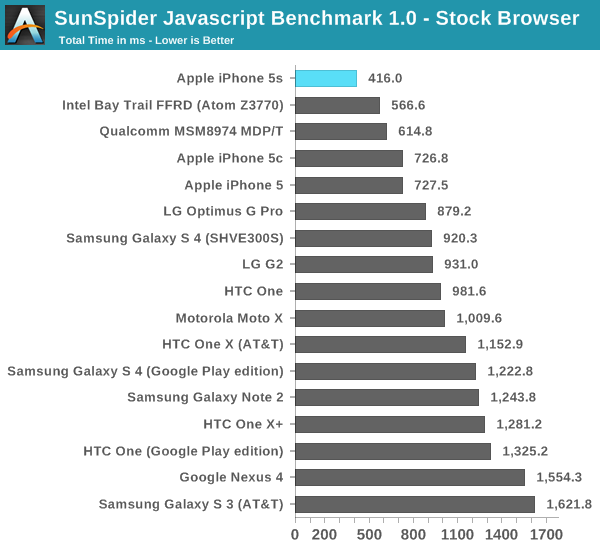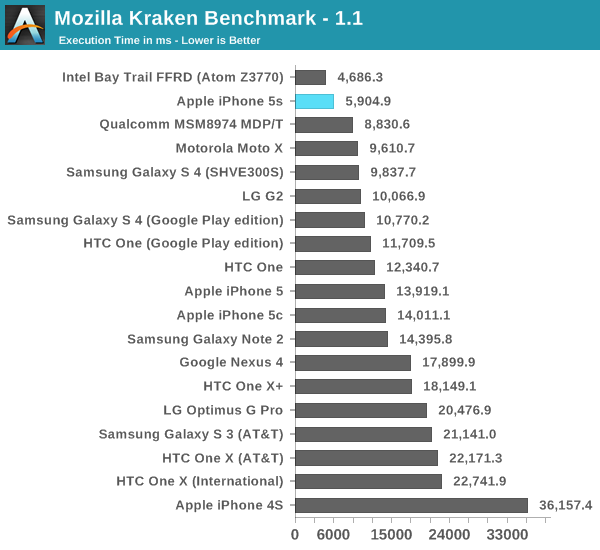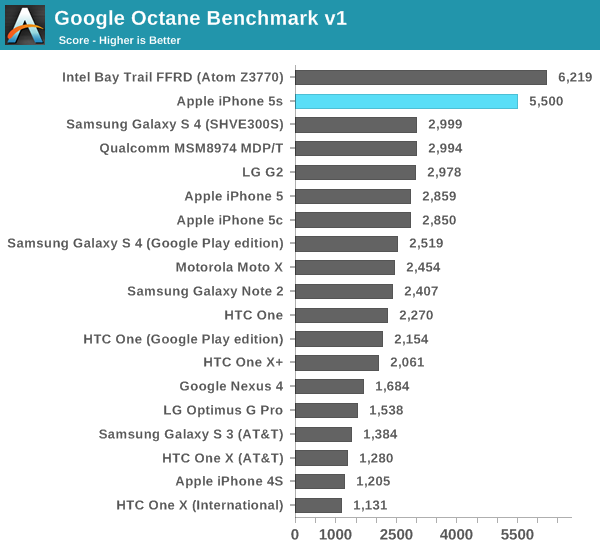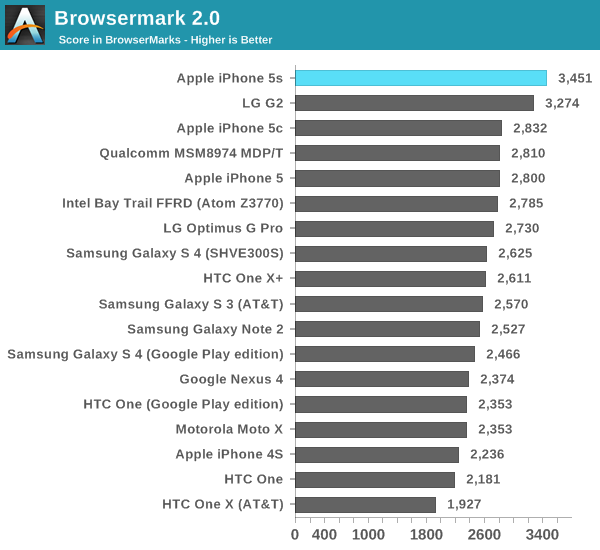The iPhone 5s Review
by Anand Lal Shimpi on September 17, 2013 9:01 PM EST- Posted in
- Smartphones
- Apple
- Mobile
- iPhone
- iPhone 5S
CPU Performance
For our cross-platform CPU performance tests we turn to the usual collection of Javascript and HTML5 based browser tests. Most of our comparison targets here are smartphones with two exceptions: Intel's Bay Trail FFRD and Qualcomm's MSM8974 Snapdragon 800 MDP/T. Both of those platforms are test tablets, leveraging higher TDP silicon in a tablet form factor. The gap between the TDP of Apple's A7 and those two SoCs isn't huge, but there is a gap. I only include those platforms as a reference point. As you're about to see, the work that Apple has put into the A7 makes the iPhone 5s performance competitive with both. In many cases the A7 delivers better performance than one or both of them. A truly competitive A7 here also gives an early indication of the baseline to expect from the next-generation iPad.
We start with SunSpider's latest iteration, measuring the performance of the browser's js engine as well as the underlying hardware. It's possible to get good performance gains by exploiting advantages in both hardware and software here. As of late SunSpider has turned into a bit of a serious optimization target for all browser and hardware vendors, but it can be a good measure of an improving memory subsystem assuming the software doesn't get in the way of the hardware.

Bay Trail's performance crown lasted all of a week, and even less than that if you count when we actually ran this benchmark. The dual-core A7 is now the fastest SoC we've tested under SunSpider, even outpacing Qualcomm's Snapdragon 800 and ARM's Cortex A15. Apple doesn't quite hit the 2x increase in CPU performance here, but it's very close at a 75% perf increase compared to the iPhone 5. Update: Intel responded with a Bay Trail run under IE11, which comes in at 329.6 ms.
Next up is Kraken, a heavier js benchmark designed to stress more forward looking algorithms. Once again we run the risk of the benchmark becoming an optimization target, but in the case of Kraken I haven't seen too much attention paid to it. I hope it continues to fly under the radar as I've liked it as a benchmark thus far.

The A7 falls second only to Intel's Atom Z3770. Although I haven't yet published these results, the 5s performs very similarly to an Atom Z3740 - a more modestly clocked Bay Trail SKU from Intel. Given the relatively low CPU frequency I'm not at all surprised that the A7 can't compete with the fastest Bay Trail but instead is better matched for a middle of the road SKU. Either way, A7's performance here is downright amazing. Once again there's a performance advantage over Snapdragon 800 and Cortex A15, both running at much higher peak frequencies (and likely higher power levels too, although that's speculation until we can tear down an S800 platform and a 5s to compare).
Compared to the iPhone 5, the 5s shows up at over 2.3x the speed of last year's flagship.
Next up is Google's Octane benchmark, yet another js test but this time really used as a design target for Google's own V8 js engine. Devices that can run Chrome tend to do the best here, potentially putting the 5s at a disadvantage.

Bay Trail takes the lead here once again, but again I expect the Z3740 to be a closer match for the A7 in the 5s at least (it remains to be seen how high the iPad 5 version of Cyclone will be clocked). The performance advantage over the iPhone 5 is a staggering 92%, and obviously there are big gains over all of the competing ARM based CPU architectures. Apple is benefitting slightly from Mobile Safari being a 64-bit binary, however I don't know if it's actually getting any benefit other than access to increased register space.
Our final browser test is arguably the most interesting. Rather than focusing on js code snippets, Browsermark 2.0 attempts to be a more holistic browser benchmark. The result is much less peaky performance and a better view at the sort of moderate gains you'd see in actual usage.

There's a fair amount of clustering around 2500 with very little differentiation between a lot of the devices. The unique standouts are the Snapdragon 800 based G2 from LG, and of course the iPhone 5s. Here we see the most modest example of the A7's performance superiority at roughly 25% better than the iPhone 5. Not to understate the performance of the iPhone 5s, but depending on workload you'll see a wide range of performance improvements.










464 Comments
View All Comments
MatthiasP - Tuesday, September 17, 2013 - link
Wow, first real review on the web AND deep as always, a very nice job from Anand. :)sfaerew - Wednesday, September 18, 2013 - link
Benchmarks(GFXBench 2.7,3DMark.Basemark X.etc.) are AArch64 version?There are 30~40% performance gap between v32geekbench and v64geekbench.
INT(ST)1471 vs 1065.
FP(ST)1339 vs 983
Wilco1 - Wednesday, September 18, 2013 - link
And Bay Trail Geekbench at 2.4GHz: 1063 (INT), 866 (FP)So A7 has beaten BT already by a huge margin despite BT not even being for sale yet...
TraderHorn - Wednesday, September 18, 2013 - link
You're comparing 64bit A7 vs 32bit BT. The 32bit #s are dead even. It'll be interesting to see if BT gets a similar performance boost when Win8 64bit versions are released in 1h 2014.Wilco1 - Wednesday, September 18, 2013 - link
BT's 32-bit result includes hardware accelerated AES, which skews its score (without it, its score is ~936). The 64-bit A7 result does also use hardware acceleration, so it is more comparable.Yes BT will get a speedup from 64-bit as well, but won't be nearly as much as A7 gets: its 32-bit result already has the AES acceleration, and x64 nearly isn't as different from x86 as A64 is from A32.
However the interesting things is that not even in 32-bit A7 wins by a good margin, but that it wins despite running at almost half the frequency of Bay Trail... Forget about Bay Trail, this is Haswell territory - the MacBook Air with the 15W 3.3GHz i7-4650U scores 3024 INT and 3003 FP.
Now imagine a quad core tablet/laptop version of the A7 running at 2GHz on TSMC 20nm next year.
smartypnt4 - Wednesday, September 18, 2013 - link
Why does the frequency matter? If the TDP of the chips are similar (Bay Trail was tested and verified by Anand as using 2.5W at the SoC level under load), who gives a flip about the frequency?If Apple wanted to double the frequency of the chip, they'd need something on the order of 4x the amount of power it already consumes (assuming a back-of-the-napkin quadratic relationship, which is approximately correct), putting it at ~6-8W or so at full load. That's assuming such a scaling could even be done, which is unlikely given that Apple built the thing to run at 1.3GHz max. You can't just say "oh, I want these to switch faster, so let's up the voltage." There's more that goes in to the ability to scale voltage than just the process node you're on.
Now, I will agree that this does prove that if Apple really wanted to, they could build something to compete with Haswell in terms of raw throughput. Next year's A8 or whatever probably will compete directly with Haswell in raw theoretical integer and FP throughput, if Apple manages to double performance again. That's not a given since they had to use ~50% more transistors to get a performance doubling from the A6 to the A7, and building a 1.5B transistor chip is nontrivial since yields are inversely proportional to the number of transistors you're using.
Next year will be really interesting, though. What with Apple's next stuff, Broadwell, the first A57 designs, Airmont, and whatever Qualcomm puts out (haven't seen anything on that, which is odd for Qualcomm.)
Wilco1 - Wednesday, September 18, 2013 - link
Frequency & process matters. Current phones use about 2W at max load without the screen (see recent Nexus 7 test), so the claimed 2.5W just for BT is way too much for a phone. That means (as you explained) it must run at a lower frequency and voltage to get into phones - my guess we won't see anything faster than the Z3740 with a max clock of 1.8GHz. Therefore the A7 will extend its lead even further.According to TSMC 20nm will give a 30% frequency boost at the same power. So I'd expect that a 2GHz A7 would be possible on 20nm using only 35% more power. That means the A7 would get 75% more performance at a small cost in power consumption. This is without adding any extra transistors.
Add some tweaks (like faster memory) and such a 2GHz A7 would be similar in performance as the 15W Haswell in MacBook Air. So my point is that with a die shrink and a slight increase in power they already have a Haswell competitor.
smartypnt4 - Wednesday, September 18, 2013 - link
Frequency and process matter in that they affect power consumption. If Intel can get Bay Trail to do 2.4GHz on something like 1.0V, then the power should be fine. Current Haswell stuff tops out its voltage around 1.1V or so in laptops (if memory serves), so that's not unreasonable.All of this assumes Geekbench is valid for comparing HSW on Win8 to ARMv8/Cyclone on iOS, which I have serious reservations about attempting to do.
The other issue I have is this: you're talking about a 50% clock boost giving a 100% increase in performance if we look at the Geekbench scores. That's simply not possible. Had you said "raise the clock to 1.6-1.7GHz and give it 4 cores," I'd be right behind you in a 2x theoretical performance increase. But a 50% clock boost will never yield a 100% increase with the same core, even if you change the memory controller.
Also, somehow your math doesn't add up for power... Are you hypothesizing that a 2GHz A7 (with 75% of the performance of Haswell 15W, not the same - as per Geekbench) can pull 2.6W while Haswell needs 15W to run that test? Granted, Haswell integrates things that the A7 doesn't. Namely, more advanced I/O (PCIe, SATA, USB, etc.), and the PCH. Using very fuzzy math, you can claim all of that uses 1/2 the power of the chip.
That brings Haswell's power for compute down to 7-8W, more or less. And you're going to tell me that Apple has figured out how to get 75% of the performance of a 7W part in 2.6W, and Intel hasn't? Both companies have ~100k employees. One is working on a ton of different stuff, and one makes processors, basically exclusively (SSDs and WiFi stuff too, but processors is their main drive). You're telling me that a (relatively) small cadre of guys at Apple have figured out how to do it, and Intel hasn't done it yet on a part that costs ~6x as much after trying to get deep into the mobile space for years. I find that very hard to believe.
Even with the 14nm shrink next year, you're talking about a 30% power savings for Intel's stuff. That brings the 15W total down to 10.5W, and the (again, super, ridiculously fuzzy) computing power to ~5-6W. On a full node smaller than what Apple has access to. And you're saying they'd hypothetically compete in throughput with a 2.6W part. I'm not sure I believe that.
Then again, I suppose theoretical bandwidth could be competitive. That's simply a factor of your peak IPC, not your average IPC while the device is running. I don't know enough about the low level architecture of the A7 (no one does), so I'll just leave it here I guess.
I'm gonna go now... I'm starting to reason in circles.
Wilco1 - Wednesday, September 18, 2013 - link
The sort of "simple" tweaks I was thinking of are: an improved memory controller and prefetcher, doubling of L2, larger branch predictor tables. Assuming a 30% gain due to those tweaks, the result is a 100% speedup at 2GHz (1.3 to 2.0 GHz is a 54% speedup, so you get 1.54 * 1.3 = 2.0x perf). The 30% gain due to tweaks is pure speculation of course, however NVidia claims 15-30% IPC gain for similar tweaks in Tegra 4i, so it's not entirely implausible. As you say a much simpler alternative would be just to double the cores, but then your single threaded performance is still well below that of Haswell.You can certainly argue some reduction in the 15W TDP of Haswell due to IO, however with Turbo it will try to use most of that 15W if it can (the Air goes up to 3.3GHz after all).
Yes I am saying that a relative newcomer like Apple can compete with Intel. Intel may be large, but they are not infallible, after all they made the P4, Itanium and Atom. A key reason AMD cited for moving into ARM servers was that designing an ARM CPU takes far less effort than an equivalent performing x86 one. So the ISA does still matter despite some claiming it no longer does.
smartypnt4 - Wednesday, September 18, 2013 - link
My point wasn't that Apple can't compete; far from it. If anything, the A7 shows they can compete for the most part. However, what you suggest is that Apple could theoretically have the same performance as Intel on a full node process larger at half the power. Ihave no illusions that Intel is infallible. Stuff like Larrabee and the underwhelming GPU in Bay Trail prove that they aren't. I just seriously doubt that Apple could beat Intel at its own game. Specifically, in CPU performance, which is an area it's dominated for years. It's possible, but I find it relatively unlikely, especially this early in Apple's lifetime as a chip designer.
On a different note, after looking at the Geekbench results more, I feel like it's improperly weighted. The massive performance improvement in AES and SHA encryption may be skewing the overall result... I need to dig more in to Geekbench before coming to an actual conclusion. I'm also still not convinced that comparing cross-platform results is actually valid. I'd like to believe it is, but I've always had reservations about it.